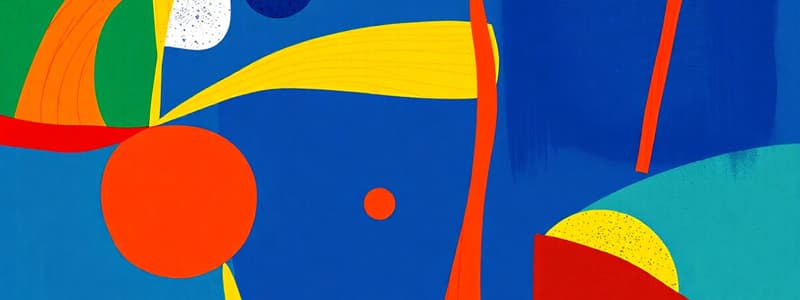Podcast
Questions and Answers
Which of the following describes the concept of rhythm in design?
Which of the following describes the concept of rhythm in design?
- The repetition of elements creating a sense of flow (correct)
- The variation in the texture of different elements
- The balance of visual weight in symmetrical arrangements
- The use of contrasting colors to draw attention
What type of balance involves two equal halves of a composition?
What type of balance involves two equal halves of a composition?
- Symmetrical Balance (correct)
- Radial Balance
- Dynamic Balance
- Asymmetrical Balance
Which element of design is defined as an area created by a line or color?
Which element of design is defined as an area created by a line or color?
- Line
- Shape (correct)
- Texture
- Form
In the context of design elements, which of the following can be considered a geometric shape?
In the context of design elements, which of the following can be considered a geometric shape?
What principle of design involves creating importance to a specific element?
What principle of design involves creating importance to a specific element?
Which of the following describes positive space in design?
Which of the following describes positive space in design?
Which type of rhythm in design involves the repetition of the same element?
Which type of rhythm in design involves the repetition of the same element?
What is the primary visual weight factor that affects balance in design?
What is the primary visual weight factor that affects balance in design?
Flashcards
Line
Line
A line is a connection between two points, extending in one dimension, such as a straight line, a dotted line, or a curved line.
Color
Color
Color is a visual element that adds vibrancy and meaning to a design. It can be used for mood, contrast, and to attract attention.
Shape
Shape
Shapes are two-dimensional areas defined by lines or colors. Geometric shapes, like circles and squares, follow rules, while organic shapes, like leaves and flowers, are more free-flowing.
Form
Form
Signup and view all the flashcards
Texture
Texture
Signup and view all the flashcards
Space
Space
Signup and view all the flashcards
Balance in Design
Balance in Design
Signup and view all the flashcards
Rhythm in Design
Rhythm in Design
Signup and view all the flashcards
Signup and view all the flashcards
Study Notes
Elements of Design
- There are six elements of design
- Line: A connection between two dots. Has one dimension (straight, curved, dotted)
- Color: A fundamental design element
- Shape: A two-dimensional area defined by a line or color. Two types - geometric (circle, etc.) and organic (leaves, flowers, etc.).
- Form (Solids): Three-dimensional objects, usually represented using shading and shadows.
- Texture: Roughness or smoothness, created using grain patterns
- Space: Positive and negative areas (objects and backgrounds)
Principles of Design
- Balance: Even distribution of visual weight in a design.
- Symmetrical: Two equal halves (left = right, top = bottom)
- Asymmetrical: Uneven visual weight, no two equal halves
- Radial: Elements radiate outward from a central point.
- Rhythm: Repetition creating patterns in design.
- Regular: Repeating the same element
- Random: Randomly repeating elements
- Alternating: Alternating elements in a pattern
- Progressive: A growth or progression in size, perhaps increasing or decreasing order
- Unity and Variety: Combining elements for harmony while maintaining differences.
- Contrast: Differences (shape, color, scale) in layout
- Emphasis/Focus: Highlighting an element
- Proportion: Relative size and dimensions of elements
- Movement: Visual paths (vertical, horizontal, diagonal) create a sense of movement (static = no movement, dynamic = movement)
Studying That Suits You
Use AI to generate personalized quizzes and flashcards to suit your learning preferences.




